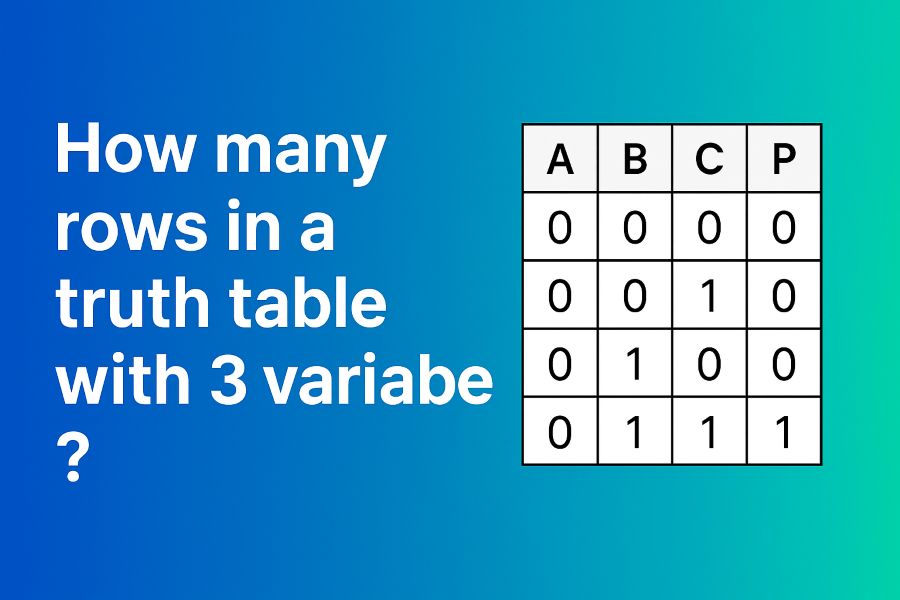Introduction
If you’re exploring logic, computer science, or digital circuit design, you’ve likely encountered truth tables. A common question is: how many rows in a truth table with 3 variables? Understanding this is crucial because the size of a truth table grows rapidly as variables increase, affecting how you analyze logical expressions.
This article explains the number of rows in truth tables with 3 variables, the underlying mathematics, practical examples, and tips to manage larger tables effectively.
What Is a Truth Table?
Before answering the main question, let’s briefly revisit what a truth table is. A truth table is a tabular representation showing all possible truth value combinations of logical variables and the resulting output of logical expressions based on those values.
The General Formula for Rows in a Truth Table
The number of rows in a truth table depends on the number of variables involved. The formula is: Number of Rows=2n\text{Number of Rows} = 2^nNumber of Rows=2n
where nnn is the number of variables.
This formula arises because each variable can take two possible values — True (T) or False (F). So, for each variable added, the number of possible combinations doubles.
How Many Rows in a Truth Table With 3 Variables?
Applying the formula: 23=82^3 = 823=8
Thus, a truth table with 3 variables will have 8 rows.
Why Does the Number of Rows Double With Each New Variable?
Each additional variable introduces two new possible truth values for every existing combination. For example:
- With 1 variable: 2 rows (T, F).
- With 2 variables: 4 rows (TT, TF, FT, FF).
- With 3 variables: 8 rows, doubling again.
This exponential growth explains why truth tables become large very quickly, making manual calculations tedious for many variables.
Visual Example: Truth Table With 3 Variables
Consider variables AAA, BBB, and CCC. The truth table lists all 8 combinations:
| A | B | C |
|---|---|---|
| T | T | T |
| T | T | F |
| T | F | T |
| T | F | F |
| F | T | T |
| F | T | F |
| F | F | T |
| F | F | F |
Each row represents a unique combination of True and False values for the three variables.
How to Use a Truth Table With 3 Variables
Once you understand the rows, you can evaluate any logical expression involving those variables by:
- Adding columns for sub-expressions and the final expression.
- Calculating truth values for each row using logical operators (AND, OR, NOT, etc.).
- Interpreting the results to analyze logical validity, equivalence, or circuit design.
Example: Truth Table With 3 Variables and Logical Expression
Suppose you want to analyze the expression: (A∧B)∨¬C(A \land B) \lor \neg C(A∧B)∨¬C
The table with 3 variables A,B,CA, B, CA,B,C will have 8 rows and columns for each sub-expression:
| A | B | C | A∧BA \land BA∧B | ¬C\neg C¬C | (A∧B)∨¬C(A \land B) \lor \neg C(A∧B)∨¬C |
|---|---|---|---|---|---|
| T | T | T | T | F | T |
| T | T | F | T | T | T |
| T | F | T | F | F | F |
| T | F | F | F | T | T |
| F | T | T | F | F | F |
| F | T | F | F | T | T |
| F | F | T | F | F | F |
| F | F | F | F | T | T |
This demonstrates the full coverage of all 3-variable input combinations.
What Happens With More Variables?
As the number of variables increases, the rows increase exponentially:
| Variables (n) | Rows (2^n) |
|---|---|
| 1 | 2 |
| 2 | 4 |
| 3 | 8 |
| 4 | 16 |
| 5 | 32 |
| 6 | 64 |
| 7 | 128 |
| 8 | 256 |
For large numbers of variables, truth tables become impractical to create manually, which is where software tools come in handy.
Tips for Managing Truth Tables With Multiple Variables
- Use online truth table generators: Tools like TruthTableGenerator.io quickly build large truth tables.
- Break expressions into sub-expressions: Evaluate parts separately to simplify calculations.
- Focus on relevant variables: Sometimes expressions depend on fewer variables; exclude irrelevant ones.
- Use software for circuit design: Professional tools can optimize logical circuits without brute-force tables.
Why Knowing the Number of Rows Matters
Understanding the number of rows helps you:
- Estimate effort needed to analyze expressions manually.
- Plan for computational resources when designing software or hardware.
- Recognize when to use tools instead of manual tables.
- Appreciate the exponential complexity of logical systems.
Frequently Asked Questions (FAQs)
How many rows are in a truth table with 3 variables?
There are 8 rows because each variable can be true or false, and 23=82^3 = 823=8.
Can I create a truth table with more than 3 variables?
Yes, but the number of rows doubles with each added variable, so tables can become very large.
Is there a way to simplify truth tables for many variables?
Yes, methods like Karnaugh maps or Boolean algebra simplification help reduce complexity.
Conclusion
The answer to how many rows in a truth table with 3 variables is straightforward: 8 rows. This is a fundamental concept in logic reflecting the exponential growth of possibilities with each added variable.
Truth tables are powerful tools for analyzing logical expressions, but as variables increase, manual methods become cumbersome. Leveraging online tools or simplification techniques becomes essential.
Understanding these principles is key for students, engineers, and anyone working with logic or digital design.
For fast and accurate truth table creation, try online generators like TruthTableGenerator.io, which handle even complex multi-variable expressions efficiently and securely.

